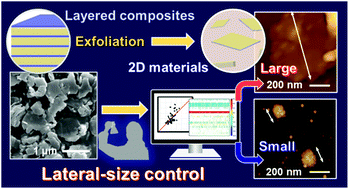Lateral-size control of exfoliated transition-metal–oxide 2D materials by machine learning on small data†
Abstract
A wide variety of nanosheets including monolayers and few-layers have attracted much interest as two-dimensional (2D) materials for the unique anisotropic structures and properties. On the other hand, one of the significant remaining and challenging issues is the lateral-size control. Since 2D materials are generally synthesized by the exfoliation of layered materials, the lateral size is not easily controlled in the breaking-down processes. The experimental factors have not been found for the control and prediction. In the present work, lateral sizes of the exfoliated transition-metal–oxide nanosheets were predicted and controlled by the assistance of machine learning. Layered composites of host inorganic layers and guest organic molecules were exfoliated into nanosheets in organic dispersion media. The lateral size of the nanosheets was estimated by dynamic light scattering (DLS), instead of microscopy methods, to achieve high-throughput analyses. Factors governing the lateral size are explored on the small experimental data by the assistance of sparse modeling, a method of machine learning. The eight physicochemical parameters of the organic guests and dispersion media were extracted by sparse modeling for the construction of the size-prediction model. The size-prediction model accelerated the selective syntheses of the nanosheets with large and small lateral sizes in a limited number of experiments. The results indicate that the prediction model is a guideline to find suitable exfoliation conditions for size control. Size-selective syntheses of a variety of 2D materials can be achieved by similar methods using sparse modeling on small experimental data. Moreover, sparse modeling is applicable to control the design and exploration of other materials and their processing based on small data.



 Please wait while we load your content...
Please wait while we load your content...